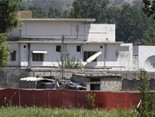 [Video below.] Bloodstained mattresses and carpets. Discarded medication bottles. Clothing hanging in a dresser, never to see its owners again. That’s what remains of the compound where Osama bin Laden met his end at the hands of a U.S. raiding team.
[Video below.] Bloodstained mattresses and carpets. Discarded medication bottles. Clothing hanging in a dresser, never to see its owners again. That’s what remains of the compound where Osama bin Laden met his end at the hands of a U.S. raiding team.
But perhaps the most revealing thing about the compound is where it’s located: deep in the heart on Pakistan, inside a sizable city, and right near a military facility. The location made Bin Laden’s compound virtually drone-proof. While his minions dodged Predators in the Pakistani wildlands, al-Qaida’s chief remained for months, maybe years, in relative safety in his sprawling urban hideout.
ABC News is the first to bring video direct from the compound in Abbotabad back to the outside world. The “first room on the right” after entering it remains “full of blood.”
That’s in contrast to its calm surroundings: The area around it looks bucolic and manicured. It’s about a kilometer away from a Pakistani military academy, tweets a journalist on the scene. Built in 2005 at the end of a dirt road, it’s about “six times” the size of any of the houses around it, with fifteen-foot high walls guarded with barbed wire.
Though its main security measures come from where it was built: 35 miles “northeast – towards India – of Islamabad and within the Pakistan air defense intercept zone for the national capital,” as the Nightwatch intelligence newsletter observes.
It means no drone could’ve pulled off the hit on Bin Laden.
The Reaper robotic plane is the most advanced in the U.S. unmanned fleet. It has a top speed of only 260 knots. And it lights up on radar like a Rockefeller Center Christmas tree. Pakistani surface-to-air-missiles would have brought it down in an instant. Nothing can fly in that region without detection and without permission from the Pakistan Air Force, even from Afghanistan,” as NightWatch notes. Of course, any possible drone shootdown near the compound would have risked tipping off bin Laden and scotching the entire painstaking manhunt.
What’s more, the Reaper doesn’t carry the weapons-load needed to ensure Bin Laden’s death. The drone carries up to four 500-pound bombs. That may sound like a lot of ordnance. But Bin Laden would’ve had plenty of places to dodge the bombs, in a compound where even the balconies had blast walls.
That’s why President Obama was presented in March with a plan to use a pair of B-2 bombers to drop “a few dozen 2,000-pound bombs” on the compound, according to ABC. The B-2s are stealthy enough – and high-flying enough – to avoid Pakistani air defense systems. And the bombers carry enough munitions to completely flatten the compound.
Eventually, the plan was called off, for fear of civilian casualties – and the destruction of bin Laden’s body, the only evidence it could present that the bombs hit their high-value target.
Instead, National Journal reports, a Navy SEAL team boarded a set of modified BlackHawk helicopters at Ghazi Air Base in Pakistan, and flew, ever-so-quietly, to Abbottabad.
According to ABC, inside the compound, the raiding team discovered “computers” – plural. Whatever information they contain is doubtlessly being picked over by intelligence officials for clues as to the locales and plans of bin Laden’s deputies, operatives and funding sources.
That’s ironic. One of the most important security measures the two brothers who hid bin Laden in the compound took was to take it off the grid. A senior intelligence official told reporters that it had “no telephone or internet service,” an anomaly for the area. (Residents even burned their trash instead of leaving it for the garbage man.) That attracted the attention of the satellite imagery sleuths of the National Geospatial-Intelligence Agency, the communications interceptions specialists of the National Security Agency and the spy-runners of the CIA – even if the latter couldn’t launch any drone strikes.
Notice that the compound itself is an intelligence asset. Its owners hid it in plain sight in the heart of Pakistan. That makes bin Laden only the latest al-Qaida leader to be taken down far from the tribal areas. Khalid Shaikh Mohammed, the architect of 9/11, was arrested in 2003 in the garrison city of Rawalpindi; another key 9/11 figure, Ramzi Binalshibh, was taken down in the port city of Karachi. Intelligence officials scouring the contents of bin Laden’s computers are surely looking for more evidence that might fit that pattern – and similar compounds.
Click below for a video report:
[media id=1141 width=400 height=300]
{Wired.com/Matzav.com Newscenter}












mazal tov
bd’e